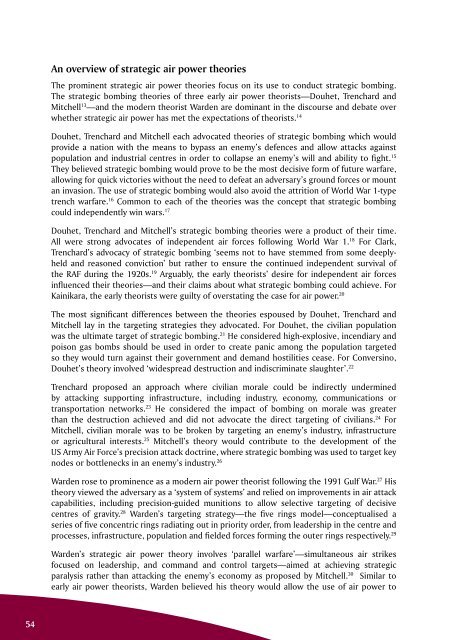190%202013%20Mar_Apr
190%202013%20Mar_Apr
190%202013%20Mar_Apr
Create successful ePaper yourself
Turn your PDF publications into a flip-book with our unique Google optimized e-Paper software.
54<br />
An overview of strategic air power theories<br />
The prominent strategic air power theories focus on its use to conduct strategic bombing.<br />
The strategic bombing theories of three early air power theorists—Douhet, Trenchard and<br />
Mitchell 13 —and the modern theorist Warden are dominant in the discourse and debate over<br />
whether strategic air power has met the expectations of theorists. 14<br />
Douhet, Trenchard and Mitchell each advocated theories of strategic bombing which would<br />
provide a nation with the means to bypass an enemy’s defences and allow attacks against<br />
population and industrial centres in order to collapse an enemy’s will and ability to fight. 15<br />
They believed strategic bombing would prove to be the most decisive form of future warfare,<br />
allowing for quick victories without the need to defeat an adversary’s ground forces or mount<br />
an invasion. The use of strategic bombing would also avoid the attrition of World War 1-type<br />
trench warfare. 16 Common to each of the theories was the concept that strategic bombing<br />
could independently win wars. 17<br />
Douhet, Trenchard and Mitchell’s strategic bombing theories were a product of their time.<br />
All were strong advocates of independent air forces following World War 1. 18 For Clark,<br />
Trenchard’s advocacy of strategic bombing ‘seems not to have stemmed from some deeplyheld<br />
and reasoned conviction’ but rather to ensure the continued independent survival of<br />
the RAF during the 1920s. 19 Arguably, the early theorists’ desire for independent air forces<br />
influenced their theories—and their claims about what strategic bombing could achieve. For<br />
Kainikara, the early theorists were guilty of overstating the case for air power. 20<br />
The most significant differences between the theories espoused by Douhet, Trenchard and<br />
Mitchell lay in the targeting strategies they advocated. For Douhet, the civilian population<br />
was the ultimate target of strategic bombing. 21 He considered high-explosive, incendiary and<br />
poison gas bombs should be used in order to create panic among the population targeted<br />
so they would turn against their government and demand hostilities cease. For Conversino,<br />
Douhet’s theory involved ‘widespread destruction and indiscriminate slaughter’. 22<br />
Trenchard proposed an approach where civilian morale could be indirectly undermined<br />
by attacking supporting infrastructure, including industry, economy, communications or<br />
transportation networks. 23 He considered the impact of bombing on morale was greater<br />
than the destruction achieved and did not advocate the direct targeting of civilians. 24 For<br />
Mitchell, civilian morale was to be broken by targeting an enemy’s industry, infrastructure<br />
or agricultural interests. 25 Mitchell’s theory would contribute to the development of the<br />
US Army Air Force’s precision attack doctrine, where strategic bombing was used to target key<br />
nodes or bottlenecks in an enemy’s industry. 26<br />
Warden rose to prominence as a modern air power theorist following the 1991 Gulf War. 27 His<br />
theory viewed the adversary as a ‘system of systems’ and relied on improvements in air attack<br />
capabilities, including precision-guided munitions to allow selective targeting of decisive<br />
centres of gravity. 28 Warden’s targeting strategy—the five rings model—conceptualised a<br />
series of five concentric rings radiating out in priority order, from leadership in the centre and<br />
processes, infrastructure, population and fielded forces forming the outer rings respectively. 29<br />
Warden’s strategic air power theory involves ‘parallel warfare’—simultaneous air strikes<br />
focused on leadership, and command and control targets—aimed at achieving strategic<br />
paralysis rather than attacking the enemy’s economy as proposed by Mitchell. 30 Similar to<br />
early air power theorists, Warden believed his theory would allow the use of air power to


